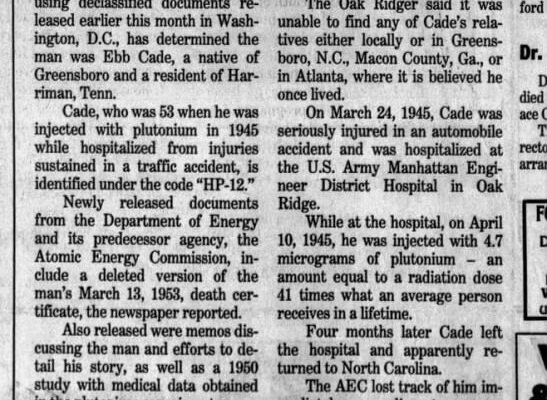Mr. Cade had been hospitalized since his accident, but the plutonium injection did not take place until April 10. On this date, « HP-12 » (the code name HP–« human product »[26]–was later assigned to this patient and to patients at the University of Rochester) was reportedly injected with 4.7 micrograms of plutonium.
A few days after Hempelmann’s March 26, 1945, recommendation that a hospital patient be injected with plutonium, Wright Langham, of the Los Alamos Laboratory’s Health Division, sent 5 micrograms of plutonium to Dr. Friedell, with instructions for their use on a human subject.[20] The subject, as it turned out, was already in the Oak Ridge Army hospital, a victim of an auto accident that had occurred on March 24, 1945.[21] He was a fifty-three-year-old « colored male »[22] named Ebb Cade,[23] who was employed by an Oak Ridge construction company as a cement mixer. The subject had serious fractures in his arm and leg, but was otherwise « well developed [and] well nourished. »[24] The patient was able to tell his doctors that he had always been in good health.[25]
Mr. Cade had been hospitalized since his accident, but the plutonium injection did not take place until April 10. On this date, « HP-12 » (the code name HP–« human product »[26]–was later assigned to this patient and to patients at the University of Rochester) was reportedly injected with 4.7 micrograms of plutonium. (It is important here to distinguish between administered dose and retained dose; not all of the injected dose would remain fixed in the body. It was not known with certainty, however, how much of the 4.7 micrograms of plutonium would remain in his body.)
The small amount of material injected into Mr. Cade would not be expected to produce any acute effects, and there is no indication that any were experienced. However, except for his fractures, Mr. Cade was apparently in good health and at age fifty-three could reasonably have been expected to live for another ten to twenty years. Thus, in Mr. Cade’s case, the risk of a plutonium-induced cancer could not be ruled out.
Dr. Joseph Howland, an Army doctor stationed at Oak Ridge, told AEC investigators in 1974 that he had administered the injection. There was, he recalled, no consent from the patient. He acted, he testified, only after his objections were met with a written order to proceed from his superior, Dr. Friedell.[27] Dr. Friedell told Advisory Committee staff in an interview that he did not order the injection and that it was administered by a physician named Dwight Clark, not Dr. Howland.[28] The Committee has not been able to resolve this contradiction.
Measurements were to be taken from samples of Mr. Cade’s blood after four hours, his bone tissue after ninety-six hours, and his bodily excretions for forty to sixty days thereafter.[29] His broken bones were not set until April 15–five days after the injection–when bone samples were taken in a biopsy.[30] Although this was several weeks after his injury, during this era when antibiotics were only beginning to become available, it was common practice to delay surgery if there was any sign of possible infection. One document records that Mr. Cade had « marked » tooth decay and gum inflammation,[31] and fifteen of his teeth were extracted and sampled for plutonium. The Committee has not been able to determine whether the teeth were extracted primarily for medical reasons or for the purpose of sampling for plutonium. In a September 1945 letter, Captain David Goldring at Oak Ridge informed Langham that « more bone specimens and extracted teeth will be shipped to you very soon for analysis. »[32] It remains unclear whether these additional bone specimens were extracted at the time of the April 15 operation or later.
According to one account, Mr. Cade departed suddenly from the hospital on his own initiative; one morning the nurse opened his door, and he was gone.[33] Later it was learned that he moved out of state and died of heart failure on April 13, 1953, in Greensboro, North Carolina.[34]
The experiment at Oak Ridge did not proceed as planned. « Before » and « after » urine samples were mistakenly commingled, so no baseline data on kidney function was available.[35] Thus, the subject’s kidney function would be difficult to assess. In May 1945,[36] Dr. Stone convened a « Conference on Plutonium » in Chicago to discuss health issues related to plutonium, including the relationship between dose and excretion rate, the permissible body burden, and potential therapy and protective measures.[37] Wright Langham spoke about the Oak Ridge injection at the conference, carefully qualifying the reliability of the excretion data obtained from Mr. Cade. Langham observed that « the patient might not have been an ideal subject in that his kidney function may not have been completely normal at the time of injection »[38] as indicated by protein tests of his urine.
https://ehss.energy.gov/ohre/roadmap/achre/chap5_2.html
https://fr.wikipedia.org/wiki/Ebb_Cade
De 1945 à 1947,18 personnes ont participé à une série d’études impliquant une injection de plutonium, dont :
- 11 personnes à Rochester, au Strong Memorial Hospital,.
- 3 personnes à Chicago, au Billings Hospital de l’Université de Chicago.
- 3 personnes à San Francisco, à l’hôpital universitaire de l’Université de Californie à San Francisco. La première personne injectée en Californie était Albert Stevens7,8,9,10.
Des échantillons d’urine et de matières fécales furent prélevés sur les sujets testés, puis envoyés à Los Alamos (également connu sous le nom de projet Y) afin d’y quantifier le plutonium rejeté11,12. Ces études menèrent à l’établissement d’un modèle mathématique du taux d’excrétion de cet élément13,14,15,2.
